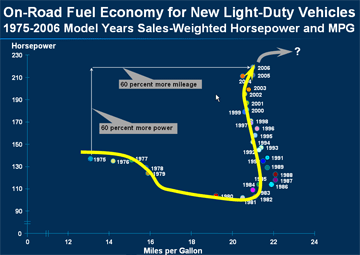At risk of blabbing too much about cars—it struck me this morning that last week’s post on vehicle efficiency might have left some people with the wrong impression.
The chart in that post showed that—despite the rise in gas prices since 1999, the fuel economy of new vehicles hasn’t increased all that much in recent years. In the chart (reproduced below), the horizontal axis represents miles per gallon, and the vertical axis shows horsepower, and the yellow arrow shows the passage of time. So… fuel economy of new vehicles increased from 1975 through 1987, but was stagnant or declining from 1988 to 2004 as horsepower skyrocketed. In 2005 and 2006, mpg improved slightly, even as horsepower continued to rise.
Now, I’m sure that some people will take this chart as proof positive that rising fuel prices have no real effect on fuel consumption. However—and I have to be quite adamant about this—it’s fairly clear that rising prices do, in fact, help to reduce fuel consumption.
The key thing to remember here is that fuel economy is only one avenue through which fuel prices affect fuel consumption. There are lots of other pathways that, cumulatively, are at least as important as the efficiency of the vehicles we buy in determining how much fuel we use.
For example, as fuel prices rise…
- Many families with access more than one vehicle respond to higher gas prices by using the most efficient car for more trips.
- Some respond to higher prices by chaining together several trips, or foregoing longer trips by choosing destinations closer to home.
- When moving or changing jobs, some folks respond to higher gas prices by choosing work that’s closer to home, or a home that’s are closer to jobs, stores, and services.
- Some people will consider telecommuting, carpooling, riding the bus instead of driving.
All of these strategies and more can reduce fuel consumption without actually improving the fuel economy of new cars.
Also, it’s worth considering Todd Litman’s consistent point about CAFE standards—namely, that by making it cheaper to drive, raising fuel efficiency standards can encourage additional driving. It’s a bit surprising, but it makes sense when you think about it: if it’s cheap to drive, you’ll drive a bit more than you otherwise would. The end result of CAFE standards is that fuel savings aren’t quite as great as the car’s mpg would lead you to believe. And—perhaps worse—congestion, crash risks, and other “external costs” that accrue by the mile all increase.
Regardless, I’ll have more data soon on transportation fuel use in the Pacific Northwest. But it’s looking to me like we’ve had yet another year in which per capita emissions in the US Northwest have fallen—and that, despite the quite modest improvements in fuel economy that the national sales figures suggest.








